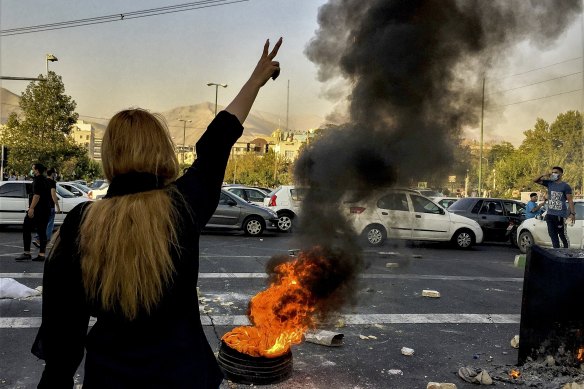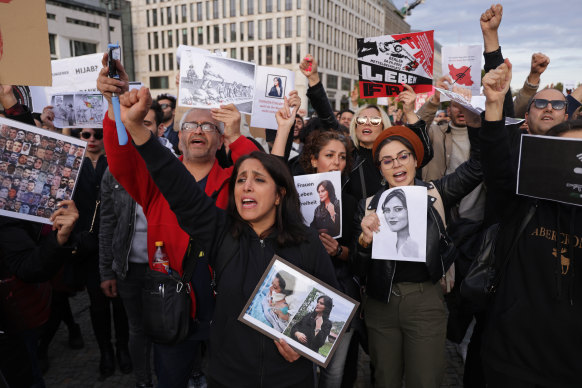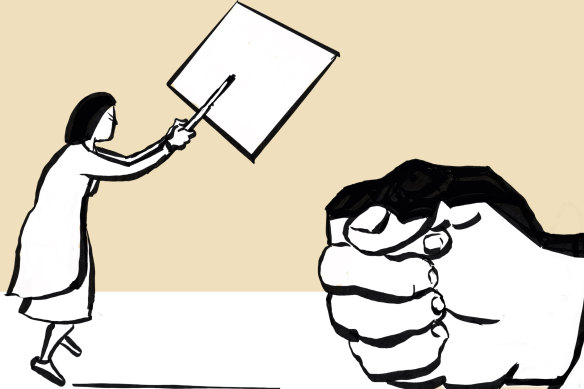Twenty-two-year-old Mahsa Amini was killed by Iran’s so-called morality police, apparently for wearing her headscarf incorrectly. It was 81 days ago that she died in detention.
Ever-tightening enforcement of the law was a priority for President Ebrahim Raisi. In July, he called on “all state institutions to enforce the headscarf law”. It was a regime “red line”.
A protest in Iran over the death in police custody of Mahsa Amini.Credit:AP
Today, the headscarf – or hijab – law is not being enforced any more. Many women in Iran are walking the streets of major cities uncovered and unimpeded. Even reportedly going unharassed through passport control.
Raisi is saying that the regime’s strict Shiite Islamic values are enshrined in Iran’s Constitution, “but there are methods of implementing the constitution that can be flexible”, according to state-run media. And the country’s parliament and judiciary are working on potential revisions to the law, according to Attorney-General Mohammad Jafar Montazeri. “We are working on the issue of hijab quickly and trying to employ a wise solution,” he said on the weekend.
What changed? The women of Iran, the young people of Iran, even the national football team of Iran, stood up. The callous murder of Mahsa Amini was the people’s “red line”.
Incensed at the regime’s brutality, fed up with harassment by the hated morality police, suffering hardship resulting from years of Western sanctions, hundreds of thousands of brave Iranians took to the streets. They demanded an end to the hijab law, to the morality police, to the very regime itself. “Women, life, freedom,” they chanted. Groups of women burned their hijabs in angry public displays. Some cut their hair off altogether. A group of schoolgirls forced a regime mullah off their school premises.
Protesters gather in Berlin, Germany, to demonstrate against the death of Mahsa Amini in Iran.Credit:Getty
The regime responded to the growing protests by sending troops to fire into the crowds with live ammunition, killing hundreds including at least 43 children, according to the Norway-based NGO Iran Human Rights.
The group said last week that a total of at least 448 people had been killed by security forces. A general in the Islamic Revolutionary Guard last week conceded that more than 300 people had died in the unrest. The UN High Commissioner for Human Rights, Volker Turk, said that 14,000 people had been arrested.
This is the regime’s true “morality” – mass murder of unarmed citizens and children to preserve power for itself.
Protesters set fire to the old family home of the founder of the Islamic Republic of Iran and longtime supreme leader, the late Ayatollah Ruhollah Khomeini. Demonstrators demanded the downfall of the current supreme leader, chanting: “Death to Khamenei!”
IllustrationCredit:Andrew Dyson
There are rumours in Tehran, denied by the authorities, that death already is stalking the supreme leader, 83, who is said to be gravely ill and was last seen in public in a state-owned TV broadcast on November 24. And on the weekend the regime appeared to suspend or disband the morality police, the “Gasht-e Ershad”, or Islamic guidance patrol. Their white vans, striped dark green, had been missing from the streets for weeks.
Asked whether they’d been disbanded, Attorney-General Montazeri said: “The guidance patrol had nothing to do with the judiciary and have been shut down from where they were set up,” according to state-run media.
Were they abolished or merely suspended? Are the relaxations lasting or temporary? Iranians awaited clarification.
At the same time, popular protest in China last week has succeeded in winning near-instant concessions from another authoritarian regime. Two separate events galvanised a week of mass unrest. Thousands of workers at a huge Foxconn factory, where Apple phones are manufactured, smashed free of their COVID lock-ins and did hand-to-hand combat with police, ultimately winning concessions from their employer.
At the same time, a fire in Xinjiang’s capital, Urumqi, killed 10 people, reported trapped by a COVID lock-in in an apartment block. Spontaneous protests of many thousands of people erupted across dozens of major Chinese cities. Some were anti-lockdown breakouts from barricaded apartment blocks, seizing freedom and demanding food.
Others were student rallies demanding free speech, free movement and the removal of Xi Jinping. The A4 Army sprang up, protesters holding sheets of blank paper across their faces to signify their voicelessness. In Chengdu they chanted: “We don’t want lifelong rulers. We don’t want emperors.” In Jinan and Korla: “Lift the lockdown!”
The official response was twofold. The protests were repressed on the streets, while COVID constraints were eased across many cities. In private conversation with EU officials, Xi Jinping acknowledged the protests. He blamed “frustrated” students.
Liberty has been in decline across the world since 2007, dubbed a “democratic recession”. The annual Democracy Report from Gothenburg University this year finds that: “The level of democracy enjoyed by the average global citizen in 2021 is down to 1989 levels. The last 30 years of democratic advances are now eradicated. Dictatorships are on the rise and harbour 70 per cent of the world population – 5.4 billion people.”
The Economist Intelligence Unit measures a mere 21 countries, out of nearly 200, as being full democracies. And yet. Ken Roth writes in Human Rights Watch’s annual report for 2022: “The superficial appeal of the rise-of-autocracy thesis belies a more complex reality – and a bleaker future for autocrats.
“As people see that unaccountable rulers inevitably prioritise their own interests over the public’s, the popular demand for rights-respecting democracy often remains strong. In country after country, large numbers of people have recently taken to the streets, even at the risk of being arrested or shot. There are few rallies for autocratic rule.”
And he wrote that before the protest movements erupted in Iran and China, two of the world’s more durable and repressive dictatorships. In both countries, regime concessions appear to have worked; the protests have ebbed. The regimes have succeeded. Yet the people have found their voices and felt their power.
Have the protests ended, or merely paused? One thing is certain. As Winston Churchill said, dictators ride tigers they dare not dismount. Holding onto power, living in fear of their people, is the only thing the dictators will be able to think about.
The Opinion newsletter is a weekly wrap of views that will challenge, champion and inform your own. Sign up here.
More from our award-winning columnists
An anxious nation: Mortgage stress, COVID burnout, extreme weather and the cost of living crisis – no wonder Australia’s status as the “lifestyle superpower of the world” is under threat – Nick Bryant
The future of democracy: Australia must learn from America’s descent into extreme inequality, which has led to deep discontent. It must also do more to civilise “social” media – the great amplifier of hate – Peter Hartcher
Behind the interview: Shane Warne may have been the greatest bowler legendary interviewer and cricket lover Michael Parkinson has ever seen, but he’s not his favourite interview – Peter FitzSimons
Most Viewed in World
From our partners
Source: Read Full Article









